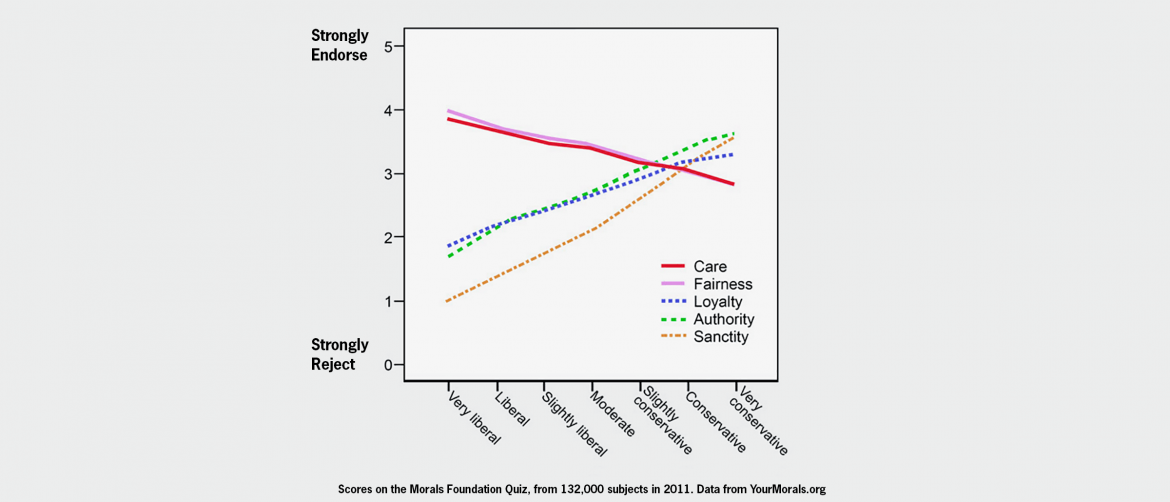Over ten years ago, social psychologist Jonathan Haidt wanted to figure out why there were such great political and religious divides in all cultures.
This little chart summarizes some big insights Haidt and his researchers uncovered.
The Righteous Mind: Why Good People Are Divided By Politics and Religion is Haidt’s well-researched study of how and why people along the spectrum from extreme liberal to extreme conservative viewpoints coalesce around certain value systems.
If Haidt is right, we all fall somewhere on this chart.
Over the course of nearly 400 pages, Haidt sympathetically explores the mindsets ranging from the far left to the far right. He considers himself a liberal Westerner (Haidt uses the term WEIRD: Western Educated Industrialized Rich Democratic), but through his life experience and dedicated research he discovered conclusions that could bring some mutual understanding, even respect, in the ongoing culture wars.
His first exploration was to prove, through rigorous experiments, that we all make social and political stances first on the basis of our emotions, then justify those emotions with various rationalizations. This is the phenomenon of confirmation bias, “the tendency to seek out and interpret new evidence in ways that confirm what you already think.” (The Righteous Mind, p.104) Conventional wisdom would posit that we reason our way into our various positions, then emotionally envelop those conclusions.
Haidt and his researchers’ process was to elicit responses from subjects and observe their reactions to some strategically crafted stories and situations. From these interviews, Haidt was able to determine key values held proportionally across political divides, from very liberal to very conservative: care, fairness, loyalty, authority, sanctity. You can read some of the interviews here. Fair warning: some of these are shocking.
“If you could only fathom the motives of your associates, how much better you would understand them. If you could only know your fellows, you would eventually fall in love with them.”
The Urantia Book 100:4.5
Looking back at the chart one can see these core values being held by all participants in the studies, but with different emphasis according to political and social mindset. There’s practically an inversion of emphasis based on the extreme ends of the spectrum from very liberal to very conservative.
The primary values held by the very liberal were, in descending order: care, fairness, then trailing significantly below these, loyalty, authority, sanctity. Among the very conservative, and in a fairly tight grouping: authority, sanctity, loyalty, care, and fairness.
The “very liberal” puts care and fairness first, and the “very conservative” first values authority and sanctity.
The Moral Foundations website offers this synopsis of each category:
- Care/harm: We feel compassion for those who are vulnerable or suffering.
- Fairness/cheating: We constantly monitor whether people are getting what they deserve, whether things are balanced. We shun or punish cheaters.
- Loyalty/betrayal: We keep track of who is “us” and who is not; we enjoy tribal rituals, and we hate traitors.
- Authority/subversion: We value order and hierarchy; we dislike those who undermine legitimate authority and sow chaos.
- Sanctity/degradation: We have a sense that some things are elevated and pure and must be kept protected from the degradation and profanity of everyday life. (This foundation is best seen among religious conservatives, but you can find it on the left as well, particularly on issues related to environmentalism.)
So considering these categories, your “conservative” friend who is against abortion and supports gun rights as a patriotic duty likely places a high value on Authority and Sanctity. Your “liberal” neighbor who is ok with the new mosque down the street and thinks health care is a universal right is probably putting Care and Fairness first. Mindfulness about these categories may help make our conversations a little less hostile and more reasonable.
The Righteous Mind was published in 2012, and Haidt was earnestly attempting to bring some level of respect and understanding to the political and religious divide.
Read this book, especially if you want insight into the political and religious extremes we’re all experiencing and want to find a way to achieve some mutual respect and peace.
“If you could only fathom the motives of your associates, how much better you would understand them. If you could only know your fellows, you would eventually fall in love with them.”
